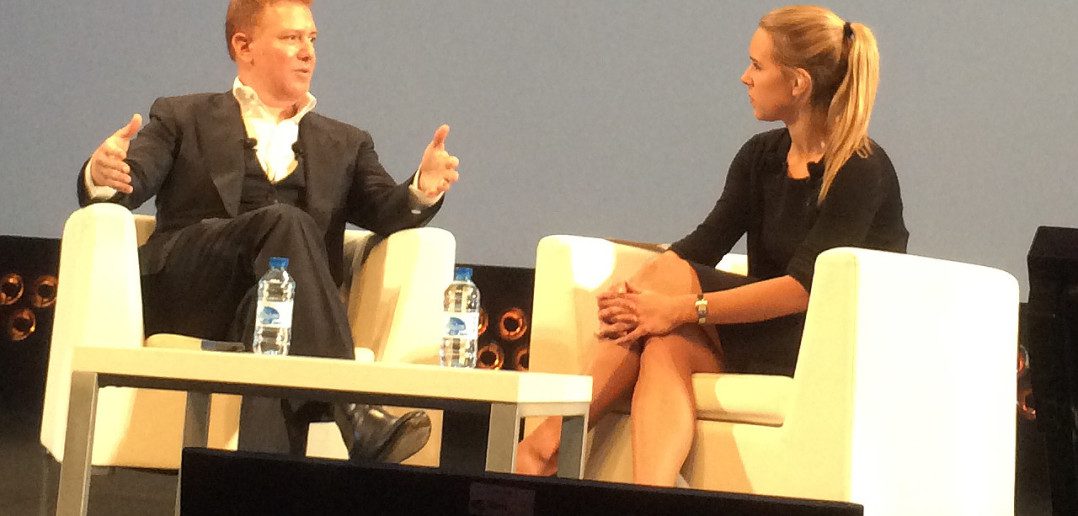Relativity Media has been described as a “next-generation studio” for the way it’s blurring the lines between film and TV, while also diversifying into other areas like sport and fashion.
It has financed nearly 200 movies and generated more than $22bn in box-office revenues, but it’s also a huge supplier of unscripted TV in the US, with a growing library of scripted shows too.
Founder and CEO Ryan Kavanaugh was the final Media Mastermind keynote at MIPCOM today. He talked about how Relativity’s business is evolving, and the impact of new trends in financing, production and distribution. His speech was followed by an on-stage interview with Alexandra Suich, media editor at The Economist.
Kavanaugh started by welcoming the disruption that’s swirling around the creative industries. “Each time a new technology platform has been introduced, we as an industry have had to adapt and evolve to survive,” he said. “We are in perhaps the most pivotal moment the industry has ever seen.”
He drilled down into a specific case study to show why: Catfish, a film released in 2010 that grossed $3.2m in the US and $240k internationally, making it the 161st grossing film of the year. While Kavanaugh stressed that it had made a small profit for Relativity, it could be seen elsewhere as an underperformer.
Yet by 2012, Catfish was a huge success as a TV show on MTV, attracting more than 2.6m viewers for the first episode, and averaging 2.4m over its first season. “When the numbers came in, the world was pretty staggered, but we were not staggered, nor were we surprised,” he said.
“Catfish is a result of us continuing to look for ways and at ways to continue to adapt as the TV and film windows collapse together… Catfish’s success has everything to do with our model.”
Kavanaugh broke down that model, explaining how Relativity sets about de-risking the costs that go into a traditional film by working with international partners, shooting in locations where it can maximise its dollars through tax rebates and credits, in order to make a profit on 85% of its films – the exact opposite of the traditional movie industry model, where 85% of films lose money, 10% break even and 5% are the blockbusters that have to make up for the rest.
“To use the baseball analogy, they’re swinging for the fences every single time… they need the biggest hits just to stay in the game,” he said, comparing traditional film financing to venture capital funding, and Relativity’s model to real estate, where its partners are the equivalent of anchor tenants for a new shopping mall that’s being built.
“It’s because of this model that we can make films like Catfish and turn them into TV shows,” he said, while also suggesting that the company has more creative freedom to explore projects that bigger studios couldn’t.
“If you think about today’s blockbuster model, it requires that successful films appeal to a very broad audience,” said Kavanaugh. “There is no place for films that only appeal to one demographic, no matter how desirable that demographic may be. But with our model, films can appeal to a demographic, and be successful just like a TV show.”
Relativity also puts lots of effort into researching the performance of its films, and the demographics of the audiences that go to see them: partly to fuel their later adaptation into TV shows.
“They are perhaps the greatest TV pilots ever known,” he said, talking about the feedback from Catfish’s theatrical, DVD/Blu-ray and VOD releases. “It became obvious that this film was one of the best TV pilots that had come out yet,” said Kavanaugh. “We had literally tested the market, and we had more market data on what they liked and didn’t like about the film than any television show in history.”
Relativity isn’t just doing this with films whose box-office performance was middling: it’s pursuing a similar strategy with Limitless, which sold just under 10m tickets, was streamed 14m times plus 4.5m times on video-on-demand, and sold well on iTunes. “With even a fraction of the conversion metrics that happened with Catfish, Limitless could have been one of the biggest network shows ever,” said Kavanaugh.
“This may sound like common sense to you, it’s actually completely foreign to the other studios. And this isn’t something that will change soon… We believe that now more than ever, we have to start with the content itself, regardless of the format, and then find a way to deliver the content to as many people as possible. For many of our films, that means television and beyond.”
A key section of Kavanaugh’s speech focused on the issue of cord-cutters: people who’ve abandoned their cable TV contracts in favour of getting their television purely from online providers like Netflix and Hulu. He noted that some people never had a cable cord to cut: “9% of US homes have never paid for television. Cable, satellite, none of the above,” he said. “And on top of that another 11% have cut the cord… That means one in five American homes do not pay for any form of traditional television.”
Kavanaugh warned that these viewers have very specific demands in terms of how, when and on what device they watch shows, as well as how they want to pay for it.
“We as an industry haven’t kept up with the way people view content,” he said. “While this industry focuses on longform, these viewers don’t see any distinction between longform, shortform, sketch… They just see content they want to consume.”
Relativity is working on an ambitious plan to cater for this new generation of viewers, by opening a new platform which will make all its films and TV shows available “in perpetuity to everyone”, as well as content co-created with its clients in the sports and fashion worlds, though its agency divisions in those sectors.
“We are ready right now to make all our movies available. We have dozens of TV shows. We have unique sports, fashion ad gaming content, and partnerships that allow us to feature content on this channel, MCN, or whatever you want to call it,” he said. “This content platform is launching, we’re in conversations with a lot of different distributors… and our plan is to have this up and running within the next 12 months.”
Bad news for traditional networks and broadcasters? Perhaps not entirely. Kavanaugh made a point of stressing that “cord-cutters and cord-keepers” are very different audiences, and the latter still care about watching first-run TV on the familiar networks. “These are two completely different audiences with different needs,” he said.
The interview section of Kavanaugh’s keynote saw him asked who he sees as the most disruptive company in the television industry. His answer was Aereo, the US company that’s retransmitting broadcast networks to computers and apps, as part of the wider cord-cutting shakeup.
The company is currently being sued by several big broadcasters, but does this need to be a battle? Kavanaugh thinks it doesn’t. “These are worlds that co-exist: 55% of the world are not going to buy Aereo, they’re going to keep their box,” he said. “Instead of fighting it… if they worked together on it, actually the cablers, MSOs and the networks could all find a way to co-exist.”
Kavanaugh also pointed to companies like Google, Amazon and Microsoft’s Xbox division as having the potential to invest huge budgets in content: either producing their own or buying up shows from elsewhere. And he finished by talking about changing windows in the television industry, saying that he doesn’t expect a near-term collapse in the windows between big movies’ theatrical releases and their appearance on digital services.
“But I do believe that the collapse of subscription and download and transaction… in two or three years, it’s 50% of the audience.”




